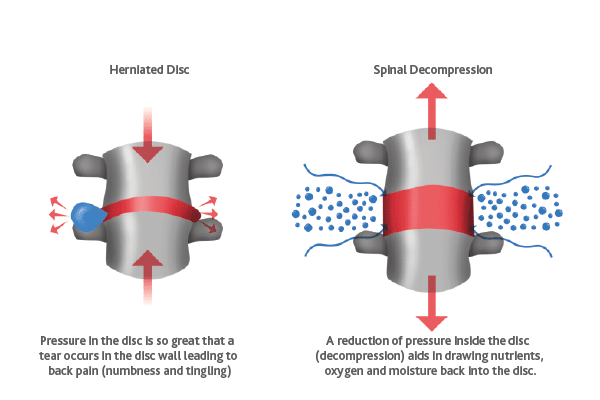Spinal Decompression Therapy

What is Spinal Decompression Therapy?
If you’re having pain in your spine, hips or joints, decompression therapy could be an option to help you feel better. This therapy can reduce pain without needing surgery. Research stated that this therapy allowing the disc to naturally return to its original position and diffusing the pressure on the nerves. Decompression therapy is a treatment that helps reduce pain from pressure on nerves by stretching out the affected area. This treatment may help if other treatments like rest, physical therapy, or acupuncture haven’t helped.
How Do You Know If You Need Decompression Therapy?
You may need decompression therapy if you have health conditions that result in nerve compression like:
- Bulging or slipped discs from joint or autoimmune conditions
- Degenerative disc diseases
- Spinal cord injuries or diseases
- Sciatica
- Spinal stenosis
Who Should not Have Spinal Decompression Therapy?
People with any of these conditions should also not have spinal decompression therapy:
- Fracture
- Tumor
- Abdominal aortic aneurysm
- Osteoporosis
- Metal implants in the spine
How does Spinal Decompression work?
Spine decompression gently stretches the spine, changing the forces on the joints. The treatment creates a negative pressure (vacuum-like effect), causing the disc to naturally retract and return to the original position. When this happens, the pressure on the nerves at the sides of the discs is reduced. By relieving pressure in the spine, increased circulation also occurs in the disc which is a vital aid in the healing process.

Effectiveness Of Spinal Decompression Therapy
Research by Gionis, Thomas MD (2003) showed that 84% - 86% reported immediate resolution of symptoms and remained pain-free 90 days post-treatment. These results show that biotechnological advances of spinal decompression therapy reveal promising results for the future of effective management of patients with disc herniation and degenerative disc diseases. Treatment was successful as defined by pain reduction; reduction in use of pain medications; normalization of range of motion and recovery of sensory or motor loss.
Other study done by C. Norman Shealy (1997) stated that 86% of ruptured intervertebral disc (RID) patients achieved 'good' (50- 89% improvement) to 'excellent' (90-100% improvement) results with decompression. Sciatica and back pain were relieved.
Other study done by C. Norman Shealy (1997) stated that 86% of ruptured intervertebral disc (RID) patients achieved 'good' (50- 89% improvement) to 'excellent' (90-100% improvement) results with decompression. Sciatica and back pain were relieved.
Aug 08,2024
